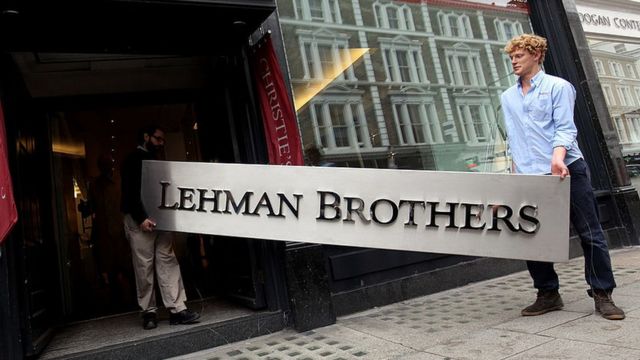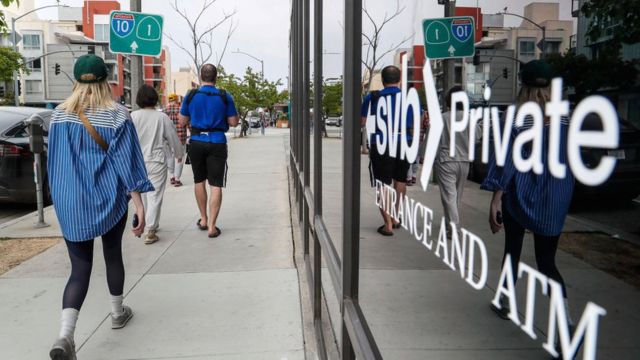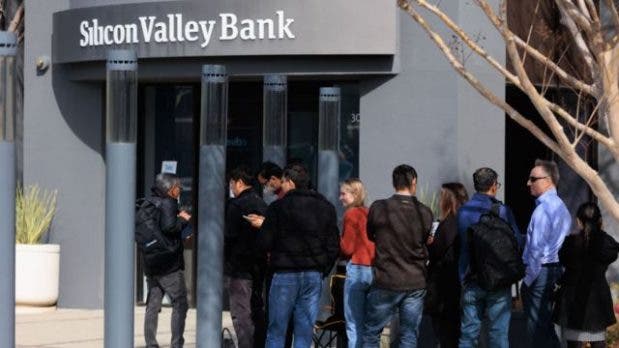One of the questions that is repeated these days is whether the collapse of the Silicon Valley Bank (SVB) could generate a financial crisis like the one of 2008.
Nearly 15 years after the “Great Recession”, which began in the US with the “junk mortgage” crisis and spread to the rest of the planet, memories of that severe economic collapse still linger.
The bank BLS It is the largest bank to be rescued in the US since the 2008 financial crisis. However, experts who have followed the events of recent days step by step agree that there are few similarities with what happened fifteen decades ago. .
Not only because the global context is different, but also because of the characteristics of the SVB and the measures taken by the authorities to try to appease fears and avoid panic on Wall Street.
Indeed, on Sunday, regulators announced that all depositors at the now-shuttered bank would be able to withdraw their money.
Even US President Joe Biden assured on Monday that the nation’s financial system is safe, wanting to project calm and avoid a “contagion effect” to the rest of the banking system.
“Your deposits will be there when you need them,” said the president.
These are some of the big differences between the collapse of SVB and the 2008 crisis.
1-SVB is not a typical bank
SVB was a bank specializing in the technology sector whose deposits came mostly from start-ups known as start upyes.
The technology sector is going through a rough time and venture capitalists, who often fund these firms, are not interested in riding the roller coaster when there is so much uncertainty in the global economy.
Uncertainty derived from a series of events such as the pandemic, the war in Ukraine and the fastest rise in the cost of credit since the 1980s.
The current economic scenario is, to put it in some way, unusual.
According to research firm Oxford Economics, SVB was “exceptionally ill-prepared to survive aggressive rate hikes from the Federal Reserve.”
If the rest of the banks have benefited from the increase in interest rates, the SVB has been harmed by being focused on the technology sector.
After making wrong investment decisions that meant losses, the bank did not resist the consequences of the increase in the cost of loans and was left without sufficient funds for its operations, which is known as lack of liquidity.
As soon as clients and investors realized something was wrong, they rushed to withdraw their funds.
That panic, which increased in a matter of hours, ended up causing the collapse.
Instead, in the 2008 crisis, the banks’ nosedive occurred because traded toxic mortgages with a massive group of clientscreating a systemic problem throughout the banking industry.
“This time it should be really different,” said Rupert Thompson, chief economist at Kingswood, because SVB’s client base is very niche and its business model revolved around technology-linked venture capital.
Instead, what caused many banks to fail in 2008 was that they all had too many high-risk real estate loans.

In the case of SVB, the loans did not fail risky accumulated for monthsInstead, the collapse occurred within hours as customers rushed to withdraw their deposits.
2-So far, there are no symptoms of contagion to the rest of the banking sector
In 2008, when Lehman Brothers bank collapsed during the subprime mortgage crash, the entire international financial system was affected.
So far, despite the nervousness that affected the stock market after the collapse of SVB, the situation has not escalated to widespread contagion Neither in the United States nor in other countries.
The response of the US authorities put the idea of ”rescue” into the debate once again. And that single word set off alarm bells. Many thought that if there is a bailout, it is because a bigger collapse could come, as happened in 2008.
But this time, the rescue was different. It was a bailout of depositors’ funds, leaving out affected shareholders and VCs.
In that sense, it was not a bailout for the banking system, as happened 15 years ago.
“SVB is not Lehman, and 2023 is not 2008”, wrote the Nobel Prize winner in Economics Paul Krugman. “We are probably not looking at a systemic financial crisis.”
On this occasion, the rescue of customer funds has been financed with the Deposit Guarantee Fund (DIF), which was created for emergency situations.
This fund is regularly financed with quarterly payments made by the banks themselves and with the interest generated by government bonds.

Regulators also hope that the sale of the SVB’s remaining assets will help finance the return of money to depositors, mostly companies.
The question of whether the government is bailing out a troubled bank remains a controversial political issue, reflecting the anger sparked by the bailout of Wall Street during the 2008 financial crisis.
In any case, unlike in 2008, it is not ordinary people who are affected by the fall of the SVB, nor their homes that are in danger.
In the “Great Recession,” millions of Americans lost their jobs and their homes.
Today, while the banking industry faces challenges, industry analysts say there does not appear to be a risk of widespread contagion.
3-There are stricter banking regulations than in 2008
“Let me make it clear that during the financial crisis there were investors and owners of big banks that were bailed out, and the reforms that were put in place mean we won’t do that again,” Treasury Secretary Janet Yellen said.
What reforms is Yellen referring to? After the Great Recession of 2008, the US Congress passed the Dodd-Frank Act.
Among other things, that law requires banks to undergo “stress tests,” or what-if scenarios, to test their ability to respond in a crisis.

The law also established minimum capital requirements for banks, a kind of buffer of funds to react when there are problems.
But in 2018, during the Donald Trump administration, the law was modified and currently only applies to banks that have assets of more than US$250 billion, and not the smallest ones.
That explains why the SVB was not subject to the same rules than the larger banks.
In fact, the former chief executive of the SVB, Greg Becker, was an advocate of raising the threshold for larger banks.
Despite the change in the law, at least the largest banks remain subject to the conditions established after the 2008 crisis.

And it is precisely these banking entities that represent a greater risk to financial stability.
To avoid further surprises, US regulators have created a new loan program so that troubled banks can use some of their financial assets as a means of obtaining a loan from the Federal Reserve.
This program essentially acts as a backstop to ensure that banks can meet the needs of their depositors.








